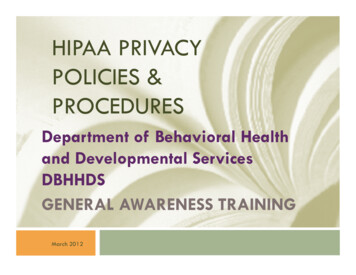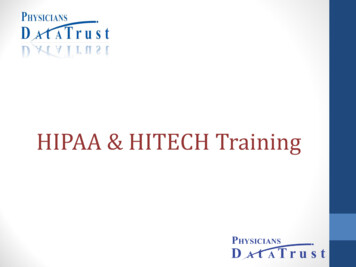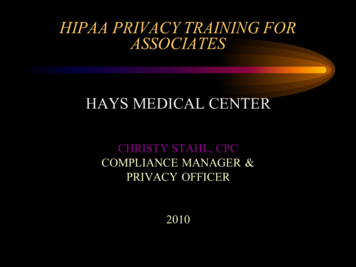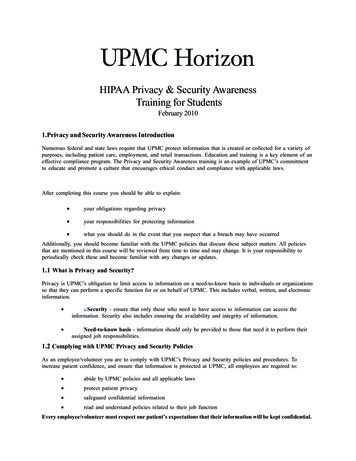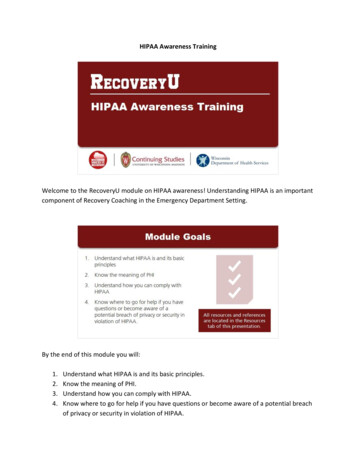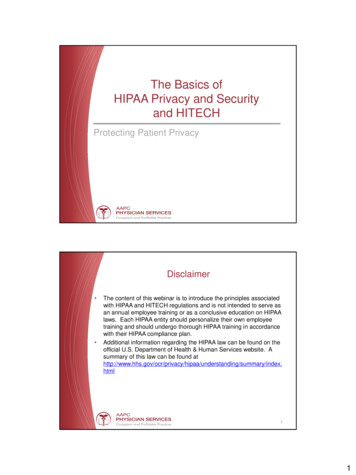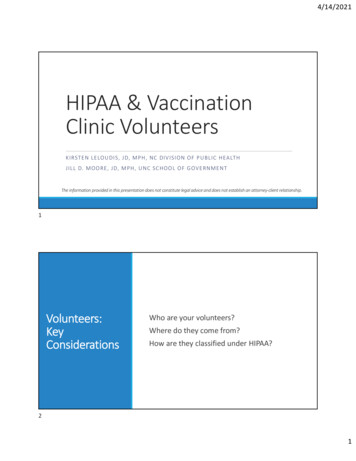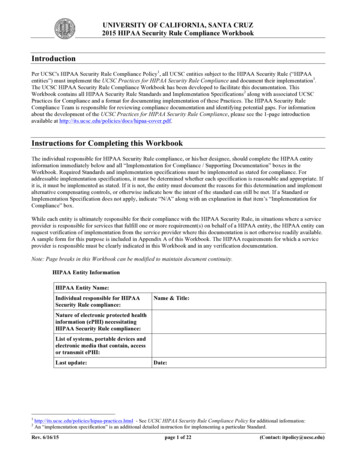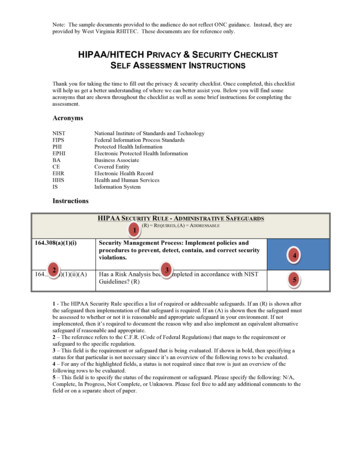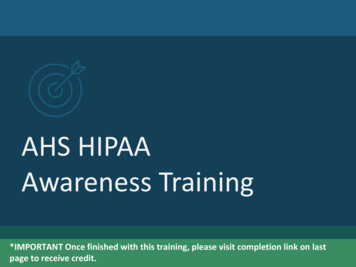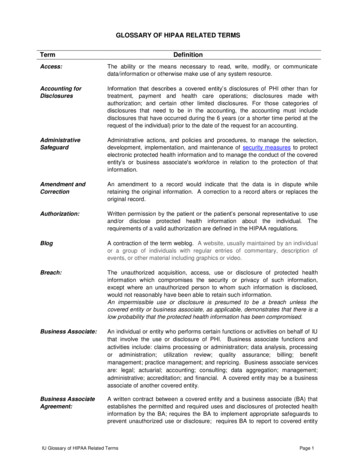
Transcription
GLOSSARY OF HIPAA RELATED TERMSTermDefinitionAccess:The ability or the means necessary to read, write, modify, or communicatedata/information or otherwise make use of any system resource.Accounting forDisclosuresInformation that describes a covered entity’s disclosures of PHI other than fortreatment, payment and health care operations; disclosures made withauthorization; and certain other limited disclosures. For those categories ofdisclosures that need to be in the accounting, the accounting must includedisclosures that have occurred during the 6 years (or a shorter time period at therequest of the individual) prior to the date of the request for an accounting.AdministrativeSafeguardAdministrative actions, and policies and procedures, to manage the selection,development, implementation, and maintenance of security measures to protectelectronic protected health information and to manage the conduct of the coveredentity's or business associate's workforce in relation to the protection of thatinformation.Amendment andCorrectionAn amendment to a record would indicate that the data is in dispute whileretaining the original information. A correction to a record alters or replaces theoriginal record.Authorization:Written permission by the patient or the patient’s personal representative to useand/or disclose protected health information about the individual. Therequirements of a valid authorization are defined in the HIPAA regulations.BlogA contraction of the term weblog. A website, usually maintained by an individualor a group of individuals with regular entries of commentary, description ofevents, or other material including graphics or video.Breach:The unauthorized acquisition, access, use or disclosure of protected healthinformation which compromises the security or privacy of such information,except where an unauthorized person to whom such information is disclosed,would not reasonably have been able to retain such information.An impermissible use or disclosure is presumed to be a breach unless thecovered entity or business associate, as applicable, demonstrates that there is alow probability that the protected health information has been compromised.Business Associate:An individual or entity who performs certain functions or activities on behalf of IUthat involve the use or disclosure of PHI. Business associate functions andactivities include: claims processing or administration; data analysis, processingor administration; utilization review; quality assurance; billing; benefitmanagement; practice management; and repricing. Business associate servicesare: legal; actuarial; accounting; consulting; data aggregation; management;administrative; accreditation; and financial. A covered entity may be a businessassociate of another covered entity.Business AssociateAgreement:A written contract between a covered entity and a business associate (BA) thatestablishes the permitted and required uses and disclosures of protected healthinformation by the BA; requires the BA to implement appropriate safeguards toprevent unauthorized use or disclosure; requires BA to report to covered entityIU Glossary of HIPAA Related TermsPage 1
GLOSSARY OF HIPAA RELATED TERMSTermDefinitionany uses and disclosures not provided for in the contract; to the extent thebusiness associate is to carry out a covered entity’s obligation under the PrivacyRule, requires the business associate to comply with the requirements applicableto the obligation; requires BA to ensure any subcontractors agree to the samerestrictions.Complaint:A statement that a situation is unsatisfactory or unacceptable; An allegation ofwrongdoing against an individual or organization.Covered Entity:A health plan, a health care clearinghouse, or a health care provider whotransmits any health information in electronic form in connection with transactionscovered by the HIPAA Privacy Rule.Critical DataData if inappropriately handled may result in criminal or civil penalties, identitytheft, personal financial loss, invasion of privacy, or unauthorized access by anindividual or many individuals (e.g., student loan information, social securitynumber, driver’s license number, passport or Visa number, state ID card numberand protected health information).Data Use Agreement:An agreement required by the Privacy Rule between a covered entity (the holderof the PHI) and a person or entity that receives the limited data set (e.g. aresearch investigator) when the data are in the form of a limited data set. A Datause agreement establishes the ways in which the information in the limited dataset may be used and how it will be protected.De-Identified HealthInformation:Health information that does not identify an individual, and with respect to whichthere is no reasonable basis to believe that the information can be used to identifyan individual.Designated RecordSet:A group of records maintained by or for a covered entity that is: the medicalrecords and billing records about individuals maintained by or for a coveredhealth care provider; enrollment, payment, claims adjudication, and case ormedical management record systems maintained by or for a health plan; or used,in whole or in part, by or for the covered entity to make decisions aboutindividuals.Any item, collection, or grouping of information that includes protected healthinformation and is maintained, collected, used, or disseminated by or for acovered entity.Disclosure:Release, transfer, provisions of, access to, or divulgence in any manner ofinformation outside the entity holding the information.Electronic ProtectedHealth Information:Protected health information (PHI) created, maintained or transmitted in electronicform (ePHI).Encryption:The use of an algorithmic process to transform data into a form in which there is alow probability of assigning meaning without use of a confidential process or key.Fundraising:Appeals for money, sponsorship of events, etc. for the benefit of a covered entity.HIPAA allows the disclosure of protected health information for this purposeIU Glossary of HIPAA Related TermsPage 2
GLOSSARY OF HIPAA RELATED TERMSTermDefinitionwithout an individual’s authorization.Health InformationExchange (HIE)The process of reliable and interoperable electronic health-related informationsharing conducted in a manner that protects the confidentiality privacy andsecurity of the information.The electronic movement of health-relatedinformation among organizations according to nationally recognized standards.Health InformationExchanges (HIE)An organization that oversees and governs the exchange of health-relatedinformation among organizations according to nationally recognized standards.Health InformationTechnology forEconomic and ClinicalHealth Act (HITECHAct):Federal law enacted as part of the American Recovery and Reinvestment Act(ARRA) of 2009. The HITECH Act promotes adoption and meaningful use ofhealth information technology; widens the scope of privacy and securityprotections available under HIPAA; increases the potential legal liability for noncompliance; and provides for more enforcement.Health InsurancePortability andAccountability Act(HIPAA):A Federal law that allows persons to qualify immediately for comparable healthinsurance coverage when they change their employment relationships. Also givesHealth and Human Services (HHS) the authority to mandate the use of standardsfor the electronic exchange of health care data; to specify what medical andadministrative code sets should be used within those standards; to require theuse of national identification systems for health care patients, providers, payers(or plans), and employers (or sponsors); and to specify the types of measuresrequired to protect the security and privacy of personally identifiable health careinformation.HealthcareOperations:Certain activities of the covered entity that are related to covered functions.These activities include, but are not limited to: administrative, financial, legal,underwriting and quality improvement activities that are necessary for a coveredentity to run its business.Incidental Use andDisclosure:Secondary use[s] and disclosure[s] of protected health information (PHI) thatcannot reasonably be prevented, limited in nature and that occur as a byproductof an otherwise permitted use or disclosure.Individual:The person who is the subject of protected health information.IndividuallyIdentifiable HealthInformation (IIHI):A subset of health information, including demographic information collected froman individual, and: (1) is created or received by a health care provider, healthplan, employer, or health care clearinghouse; and (2) relates to the past, present,or future physical or mental health or condition of an individual; the provision ofhealth care to an individual; or the past, present, or future payment for theprovision of health care to an individual; and identifies the individual or there is areasonable basis to believe the information can be used to identify the individual.IU Glossary of HIPAA Related TermsPage 3
GLOSSARY OF HIPAA RELATED TERMSTermDefinitionIU FundraisingPersonnel:Includes any IU employees or other IU personnel, including but not limited to theIU Office of Gift Development, who perform any fundraising activities on behalf of,or in affiliation, with another covered entity, such as the IU Health Physicians, theIU School of Medicine Clinical Departments or other HIPAA Covered Entity, andmay have access to or use Protected Health Information for fundraising purposes.IU HIPAA AffectedAreas(IU HAAs):Any school, department, division, or unit that may be a health care component;perform business associate services to another covered entity or a health carecomponent; or have access to protected health information for education and/orresearch purposes.Limited Data Set:A data set of protected health information that excludes specified direct identifiersrelated to an individual or of relatives, employers, or household members of theindividual, but retains geographic subdivisions larger than the postal address,elements of dates including month and day as well as other unique identifyingnumbers, characteristics or codes not previously listed as a direct identifier andcannot reasonably be used to identify an individual. Limited data sets may only beused for research, public health or for health care operations; and only inconjunction with a data use agreement.MalwareShort for malicious software. Software the is intended to damage or disablecomputers and computer systems. Malware includes computer programs knownas viruses, worms, Trojans, ransomware and spyware.Marketing:A communication about a product or service that encourages recipients of thecommunication to purchase or use the product or service. Using protected healthinformation for marketing purposes requires an authorization from the patient,unless the communication is: a face-to-face communication made by a coveredentity to an individual; or a promotional gift of nominal value.Minimum Necessary:A standard that requires covered entities to take reasonable steps to limit the useor disclosure of, and requests for PHI to the minimum necessary to accomplishthe intended purpose. The minimum necessary standard does not apply to certainuses or disclosures such as those requests by a health care provider fortreatment purposes, disclosures to the individual who is the subject of theinformation or pursuant to an individual’s authorization.Mobile ComputingDevice or MobileDevice:A small device, typically small enough to be handheld, that is capable ofcollecting, storing, transmitting, or processing electronic data or images. Thesemay include a cellular telephone, mobile phone, smart phone, PDA, non-laptopbased tablet (e.g. iPad, kindle, android), or USB-device. IU includes laptop andnotebook computers in its definition of “mobile device”.Notice of PrivacyPractices:The Rule requires health plans and covered health care providers to provideadequate notice that provides a clear, user friendly explanation of the individual’slegal rights with respect to their personal health information and the privacypractices of the covered entity.IU Glossary of HIPAA Related TermsPage 4
GLOSSARY OF HIPAA RELATED TERMSTermDefinitionObserver:An individual who has:1. Completed the forms required by this Guidance Document2. Been approved by a Unit: and3. Been assigned to a Supervisor within a Unit to shadow an employee orhealthcare provider.It is highly recommended that Observers be at least 18 years of age to do an onthe job shadowing experience with a healthcare provider.PhishingThe activity of defrauding an online account holder by posing as a legitimatecompany or person.Phishing SchemesA form of fraud in which the attacker tries to learn information such as logincredentials or account information by masquerading as a reputable entity orperson in email IM or other communication channels.Physician-Patient email:Computer-based communication between physicians or associated medicalpersonnel and patients within a professional relationship in which the physicianhas taken on an explicit measure of responsibility for the patient’s care. [844 IAC5-1-1]These guidelines do not apply to communication between caregivers andconsumers in which no on-going professional relationship exists. E-mailcommunications does not include communication via social networking sites orcell phone short messaging services (texting).Payment:Activities undertaken by a health care provider to obtain payment or bereimbursed for their services and of a health plan to obtain premiums, to fulfilltheir coverage responsibilities and provide benefits under the plan, and to obtainor provide reimbursement for the provision of health care.Personally IdentifiableInformation (PII):Information which can be used to distinguish or trace an individual's identity, suchas their name, Social Security Number, biometric records, etc. alone, or whencombined with other personal or identifying information which is linked or linkableto a specific individual, such as date and place of birth, mother’s maiden name,etc. It includes information that is linked or linkable to an individual, such asmedical, educational, financial and employment information.Physical SafeguardsPhysical measures, policies and procedures to protect a covered entity’s paperrecords and electronic information systems and related building and equipmentfrom natural and environmental hazards and unauthorized intrusion.Protected HealthInformation (PHI):Individually identifiable health information held or transmitted by a covered entityor its business associate in any form or medium, whether electronic, on paper ororal.Recording:The action or process of storing sounds and images on electronic media or paperso they can be heard and/or seen again. Includes all methods of recordingphotographs, images, videos, audio and other digital or electronic media by whichthe identity of the recorded individual may be determined.IU Glossary of HIPAA Related TermsPage 5
GLOSSARY OF HIPAA RELATED TERMSTermDefinitionSafeguards:Specific actions which are designed to protect the privacy and security of anindividual’s health information. These actions may include: administrativemeasures such as policies, procedures, training and written agreements; physicalmeasures such as locked doors or keycard access; and technical measures suchas firewalls, password/passphrase and encryption.Sanitizing electronicmedia:A process by which data is irreversibly removed from media or the media ispermanently destroyed. It includes removing all classified labels, markings, andactivity logs.Secure Destruction:The result of actions taken to ensure that media cannot be reused as originallyintended and that information is virtually impossible to recover.Security IncidentResponse Team:A group of individuals created to assist with an incident investigation. The incidentresponse team will be activated at the discretion of the Information Security Office(ISO). The core IU Health incident response team members will be decided witheach incident by the ISO. This team may typically consist of General Counselrepresentatives, IS representatives, a Media Relations Office representative, anda Compliance Office representative.Security Incident:The attempted or successful unauthorized access, use, disclosure, modification,or destruction of information or interference with system operations in aninformation system.Site:The location where an Observer will watch an employee or Faculty member atwork. The healthcare facility or practice that occupies the Site will be responsiblefor the administration of the shadowing experience in accordance with this policyor the facility’s policy. For purposes of this policy, the term site may include butnot be limited to a school clinic, department, practices, clinics or hospitalsaffiliated with Indiana University.Social NetworkingSites:Internet sites that provide a variety of ways for users to interact, such as e-mailinstant messaging, posting informational web pages and picture exchangeservices. Common Internet social networking sites are Facebook, Twitter,Instagram, LinkedIn, Pinterest, Google Plus , Tumblr, VK, Flickr, Vine andMyspace.Social Networking:Online communities of people who share interests and/or activities, or who areinterested in exploring the interests and activities of others. Most social networkservices are web based and provide a variety of ways for users to interact, suchas e-mail instant messaging and picture exchange services.Supervisor:An individual employed by or affiliated with the respective Health Science Schoolor affiliated healthcare facility participating in the job shadowing experience and isresponsible for determining when access to confidential information isappropriate.TechnicalSafeguardsThe technology and the policy and procedures for its use that protect electronicprotected health information and control access to it.IU Glossary of HIPAA Related TermsPage 6
GLOSSARY OF HIPAA RELATED TERMSTermDefinitionTreatment:The provision, coordination, or management of health care and related servicesby one or more health care providers, including the coordination or managementof health care by a health care provider with a third party; consultation betweenhealth care providers relating to a patient; or the referral of a patient for healthcare from one health care provider to another.Use:With respect to individually identifiable health information, the sharing,employment, application, utilization, examination, or analysis of such informationwithin an entity that maintains such information.User:A person who uses a computer or network service. At IU this includes faculty,staff, students, affiliates, temporary workers, retired faculty, retired staff and anyindividuals or entities that use or have authorized access to IU’s network.Unit:A clinical or non-clinical department within one of IU’s Health Science Schools.Workforce member:Employees, volunteers, trainees (including students, residents and fellows), andother persons whose conduct, in the performance of work for a covered entity, isunder the direct control of such entity, whether or not they are paid by thecovered entity.IU Glossary of HIPAA Related TermsPage 7
IU Glossary of HIPAA Related Terms Page 5 Term Definition Observer: An individual who has: 1. Completed the forms required by this Guidance Document 2. Been approved by a Unit: and 3. Been assigned to a Supervisor within a Unit to shadow an employee or healthcare provider. It is highly recommended that Observers be at least 18 years of age to .
